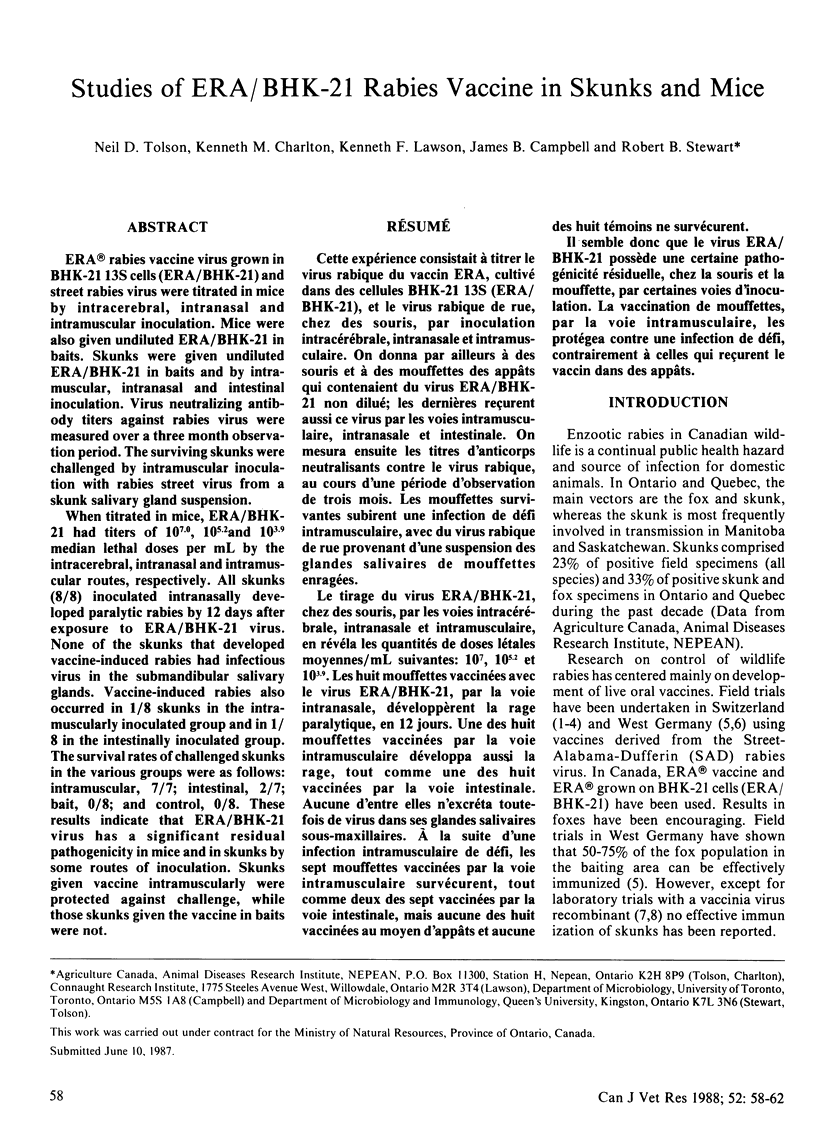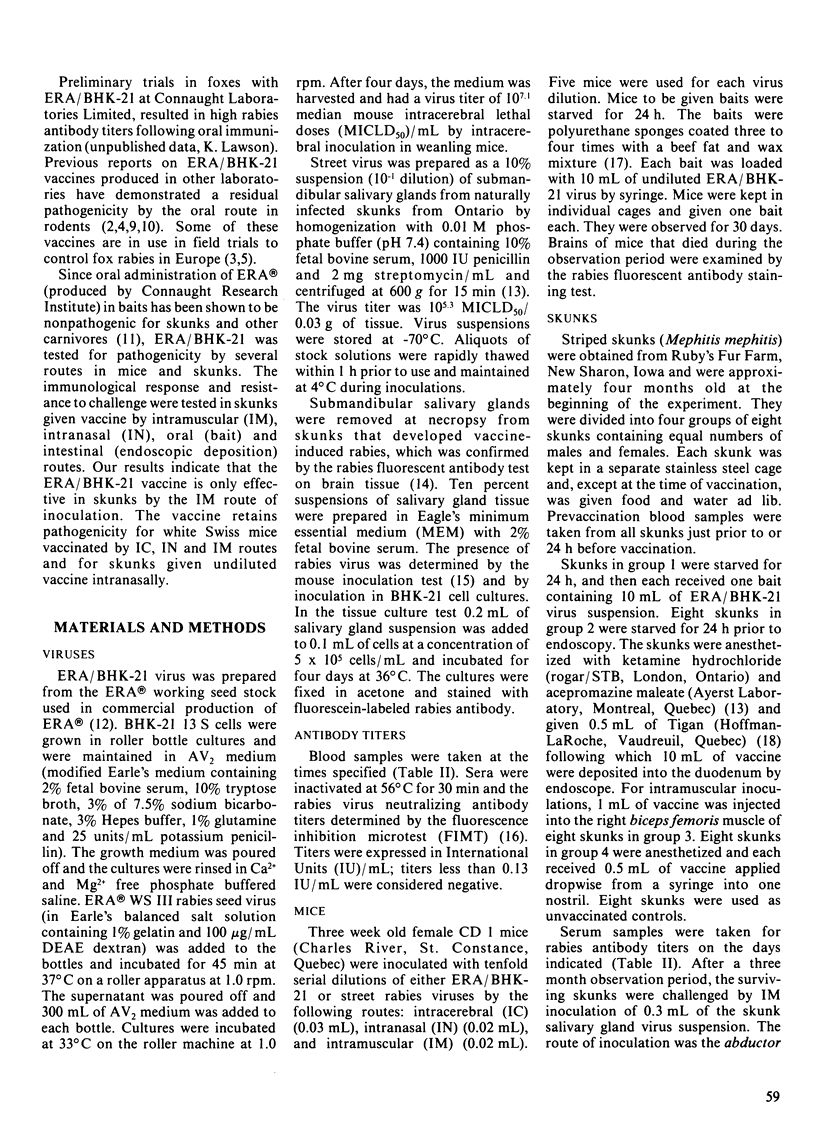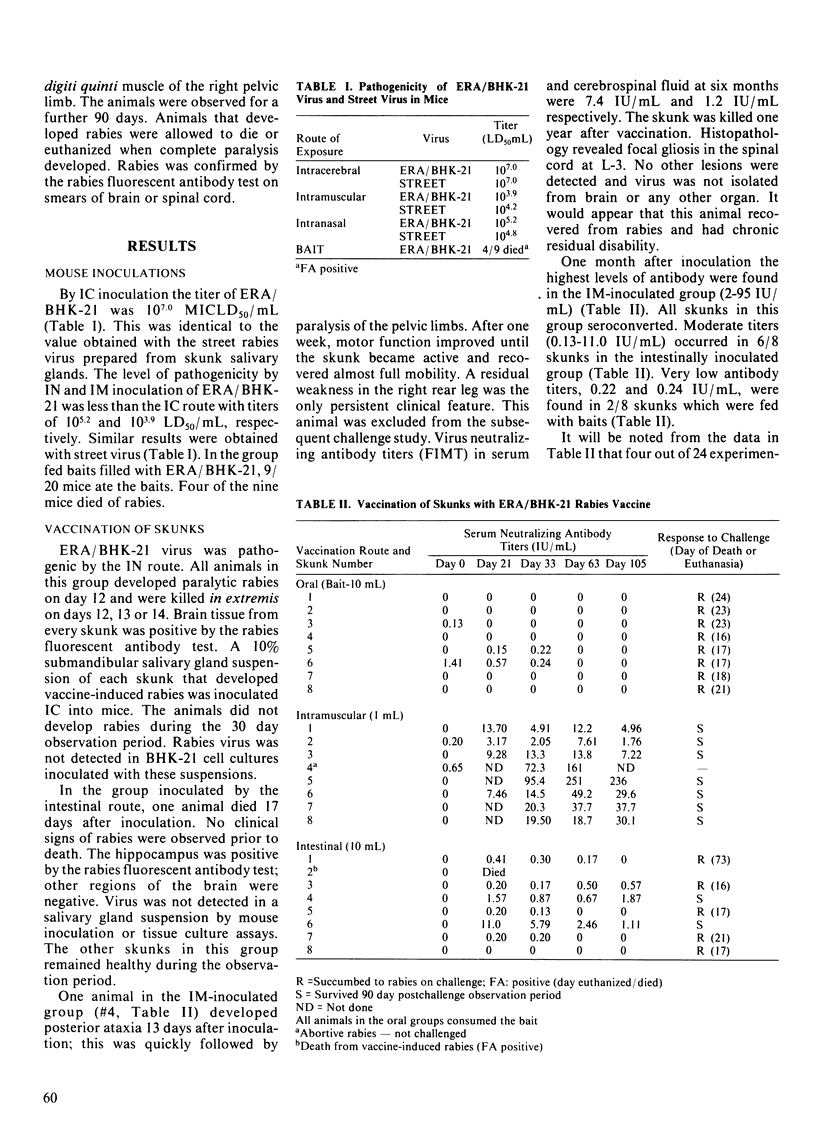Abstract
ERA rabies vaccine virus grown in BHK-21 13S cells (ERA/BHK-21) and street rabies virus were titrated in mice by intracerebral, intranasal and intramuscular inoculation. Mice were also given undiluted ERA/BHK-21 in baits. Skunks were given undiluted ERA/BHK-21 in baits and by intramuscular, intranasal and intestinal inoculation. Virus neutralizing antibody titers against rabies virus were measured over a three month observation period. The surviving skunks were challenged by intramuscular inoculation with rabies street virus from a skunk salivary gland suspension. When titrated in mice, ERA/BHK-21 had titers of 10(7.0), 10(5.2) and 10(3.9) median lethal doses per mL by the intracerebral, intranasal and intramuscular routes, respectively. All skunks (8/8) inoculated intranasally developed paralytic rabies by 12 days after exposure to ERA/BHK-21 virus. None of the skunks that developed vaccine-induced rabies had infectious virus in the submandibular salivary glands. Vaccine-induced rabies also occurred in 1/8 skunks in the intramuscularly inoculated group and in 1/8 in the intestinally inoculated group. The survival rates of challenged skunks in the various groups were as follows: intramuscular, 7/7; intestinal, 2/7; bait, 0/8; and control, 0/8. These results indicate that ERA/BHK-21 virus has a significant residual pathogenicity in mice and in skunks by some routes of inoculation. Skunks given vaccine intramuscularly were protected against challenge, while those skunks given the vaccine in baits were not.
Full text
PDF




Selected References
These references are in PubMed. This may not be the complete list of references from this article.
- Abelseth M. K. An Attenuated Rabies Vaccine for Domestic Animals Produced in Tissue Culture. Can Vet J. 1964 Nov;5(11):279–286. [PMC free article] [PubMed] [Google Scholar]
- Black J. G., Lawson K. F. Sylvatic rabies studies in the silver fox (Vulpes vulpes). Susceptibility and immune response. Can J Comp Med. 1970 Oct;34(4):309–311. [PMC free article] [PubMed] [Google Scholar]
- Black J. G., Lawson K. F. The safety and efficacy of immunizing foxes (Vulpes vulpes) using bait containing attenuated rabies virus vaccine. Can J Comp Med. 1980 Apr;44(2):169–176. [PMC free article] [PubMed] [Google Scholar]
- Charlton K. M., Casey G. A., Campbell J. B. Experimental rabies in skunks: mechanisms of infection of the salivary glands. Can J Comp Med. 1983 Jul;47(3):363–369. [PMC free article] [PubMed] [Google Scholar]
- Dean D. J., Abelseth M. K. Laboratory techniques in rabies: the fluorescent antibody test. Monogr Ser World Health Organ. 1973;(23):73–84. [PubMed] [Google Scholar]
- Esh J. B., Cunningham J. G., Wiktor T. J. Vaccine-induced rabies in four cats. J Am Vet Med Assoc. 1982 Jun 1;180(11):1336–1339. [PubMed] [Google Scholar]
- Frost J. W., Wachendörfer G., Gutmann B., Dingeldein W., Schneider L. G. Erste Erfahrungen mit der oralen Immunisierung von Füchsen gegen Tollwut in Hessen. Berl Munch Tierarztl Wochenschr. 1985 Aug 1;98(8):279–281. [PubMed] [Google Scholar]
- Kieny M. P., Lathe R., Drillien R., Spehner D., Skory S., Schmitt D., Wiktor T., Koprowski H., Lecocq J. P. Expression of rabies virus glycoprotein from a recombinant vaccinia virus. Nature. 1984 Nov 8;312(5990):163–166. doi: 10.1038/312163a0. [DOI] [PubMed] [Google Scholar]
- Lawson K. F., Black J. G., Charlton K. M., Johnston D. H., Rhodes A. J. Safety and immunogenicity of a vaccine bait containing ERA strain of attenuated rabies virus. Can J Vet Res. 1987 Oct;51(4):460–464. [PMC free article] [PubMed] [Google Scholar]
- Lawson K. F., Johnston D. H., Patterson J. M., Black J. G., Rhodes A. J., Zalan E. Immunization of foxes Vulpes vulpes by the oral and intramuscular routes with inactivated rabies vaccines. Can J Comp Med. 1982 Oct;46(4):382–385. [PMC free article] [PubMed] [Google Scholar]
- Rhodes A. J. Strains of rabies virus available for preparation of sylvatic rabies vaccines with special reference to vaccines prepared in cell culture. Can Vet J. 1981 Aug;22(8):262–266. [PMC free article] [PubMed] [Google Scholar]
- Steck F., Wandeler A., Bichsel P., Capt S., Häfliger U., Schneider L. Oral immunization of foxes against rabies. Laboratory and field studies. Comp Immunol Microbiol Infect Dis. 1982;5(1-3):165–171. doi: 10.1016/0147-9571(82)90031-5. [DOI] [PubMed] [Google Scholar]
- Steck F., Wandeler A., Bichsel P., Capt S., Schneider L. Oral immunisation of foxes against rabies. A field study. Zentralbl Veterinarmed B. 1982 Jun;29(5):372–396. doi: 10.1111/j.1439-0450.1982.tb01237.x. [DOI] [PubMed] [Google Scholar]
- Tolson N. D., Charlton K. M., Stewart R. B., Campbell J. B., Wiktor T. J. Immune response in skunks to a vaccinia virus recombinant expressing the rabies virus glycoprotein. Can J Vet Res. 1987 Jul;51(3):363–366. [PMC free article] [PubMed] [Google Scholar]
- Wandeler A. I., Bauder W., Prochaska S., Steck F. Small mammal studies in a SAD baiting area. Comp Immunol Microbiol Infect Dis. 1982;5(1-3):173–176. doi: 10.1016/0147-9571(82)90032-7. [DOI] [PubMed] [Google Scholar]
- Winkler W. G., McLean R. G., Cowart J. C. Vaccination of foxes against rabies using ingested baits. J Wildl Dis. 1975 Jul;11(3):382–388. doi: 10.7589/0090-3558-11.3.382. [DOI] [PubMed] [Google Scholar]
- Zalan E., Wilson C., Pukitis D. A microtest for the quantitation of rabies virus neutralizing antibodies. J Biol Stand. 1979 Jul;7(3):213–220. doi: 10.1016/s0092-1157(79)80024-4. [DOI] [PubMed] [Google Scholar]


